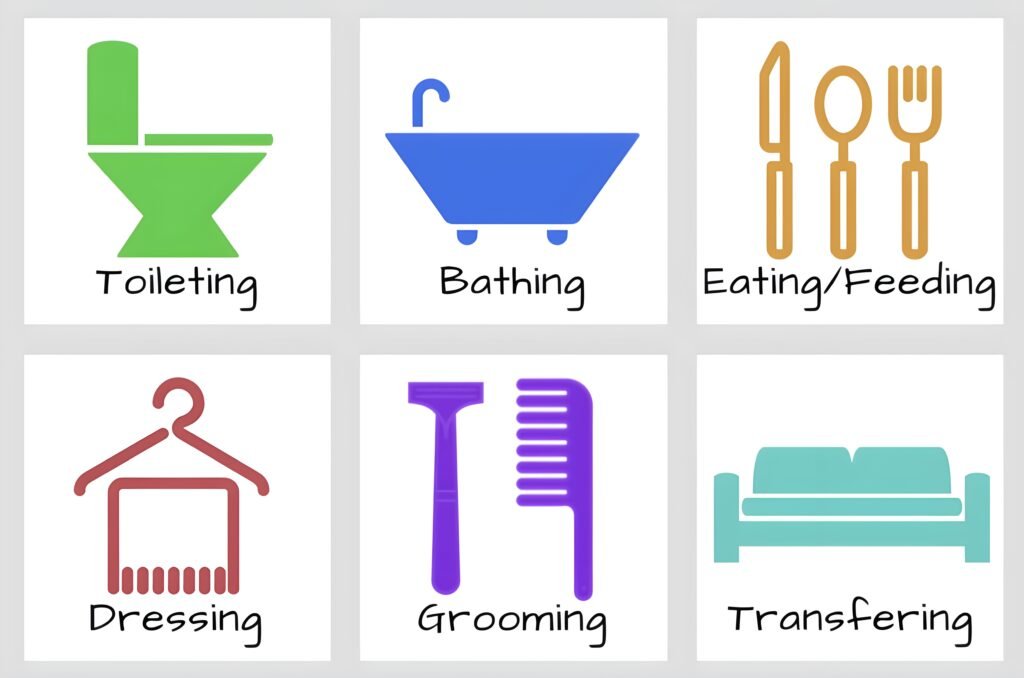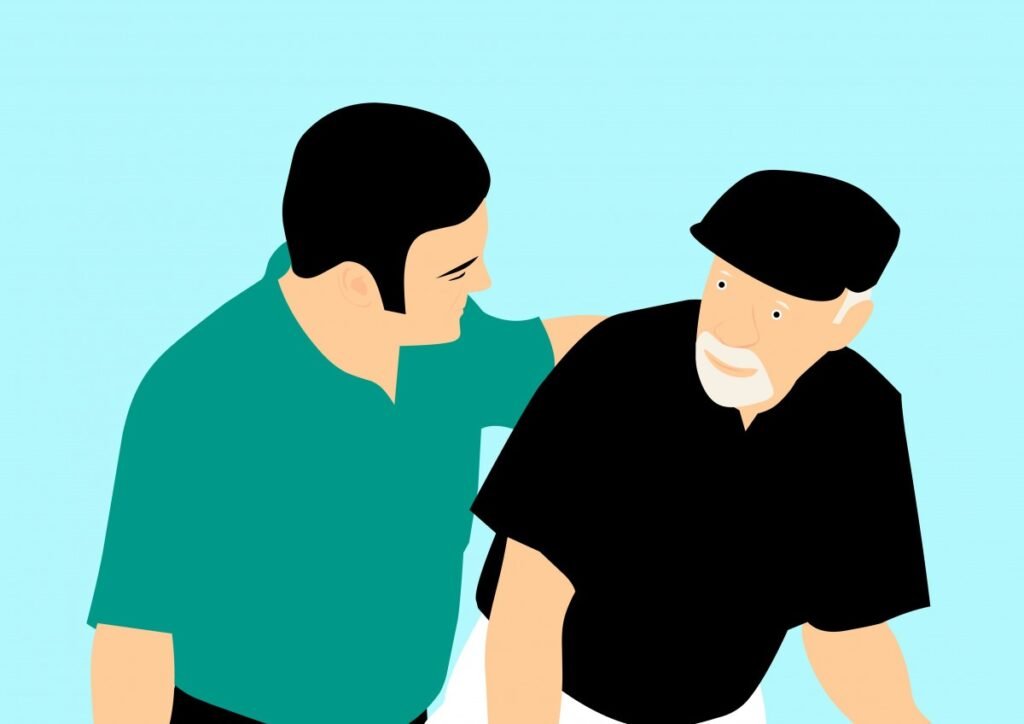6 Activities of Daily Living & Need for Long-Term Care [UPDATED]
The small tasks that are performed every day without acknowledging their significance by most individuals are activities of daily living (ADLs). These tasks are usually completed by most adolescents and adults without any assistance provided.
However, some may struggle with these daily tasks due to age or illnesses, compromising the quality of life for such individuals. That is when one realizes the need for a helping hand or a care center. This article aims to explore the role of ADLs in one’s life, the assessment of ADLs, and their relation with long-term care facilities.
The 6 ADLs
The 6 primary activities of daily living set out the criteria for healthy and properly functioning individuals. These tasks are carried out every day but they usually go unnoticed.
The importance of these tasks is realized only when one needs external assistance to perform them.


Eating
The simple yet complicated procedure of putting food in the mouth, chewing, and swallowing it. This daily life activity may become hard as life progresses. One may require assistance or depend on families or caregivers to help him or her consume food.
This daily life activity is not only about consuming food physically but also about the cognitive process that helps them recognize the need to eat food.
Dressing
The ability to choose appropriate clothes and put them on, adjust them according to individual needs and wishes, and get them off without any external help.
This daily life activity includes everything related to clothes and garments. Tying shoelaces, putting on a belt, closing zippers, tying a tie, and fastening buttons are all considered ADLs.
Bathing
This daily life activity involves the ability to maintain personal hygiene. It includes activities like showering, cutting nails, washing hair, grooming oneself, putting soap and rinsing it off, and oral care.
Bathing is typically done without any assistance however, with certain complications, one may feel the need to execute the task with some aid.
Continence
Continence involves the ability to control the bladder and bowel function. This daily life activity revolves around recognizing the need to use the toilet, having control over the bladder, and maintaining hygiene after using the toilet.
With certain health complications, individuals may lose their sense of recognition to use a toilet and lose control over their bladders leading to urinary or fecal incontinence.
Toileting
One’s ability to use a toilet, get to and from it, and maintain cleanliness is one of the other vital ADLs. Toileting includes preventing oneself from incontinence too.
Elderly people usually lose control over this daily life activity and require their families or caregivers to help them carry out this task.
Transferring
The last essential ADL is transferring which refers to one’s ability to move from one surface to another. The ability to move from a chair to a bed or get in or out of a car are all examples of transferring.
This daily life activity provides individuals with a sense of freedom and independence as they can move according to their will. However, with certain complications, this daily life activity may be compromised.
How are ADLs Related to Long-Term Care?
ADLs define the criteria of a healthy and independent individual. If an individual is fulfilling daily activities without any struggle or needing any external help, he or she is likely to be called a physically or mentally healthy being.
On the other hand, some individuals may find it hard to accomplish these goals all by themselves or require some sort of assistance from caregivers or families. Such people are likely to be called physically unfit as they may depend on others for basic daily life activities. Depending on others can also induce feelings of helplessness or isolation.
However, it is crucial for such individuals to be provided with long-term care to improve their quality of life by giving them the support and care they need. If you or your loved ones have difficulties executing daily life tasks, it is essential to reach out to long-term care centers and get the help you require.
How Does ADLs Assessment Work?
Healthcare professionals usually conduct assessment methods for individuals struggling to complete their daily life tasks. The form may be a self-report or one based on observations, filled out by families or caregivers.
The medical professional gains insight into an individual’s physical or mental capability by using ADL assessment tools such as Functional Assessment Report (FAR). If the respective person is unable to complete 3 out of 6 ADLs, he or she is eligible for the financial aid program regarding medical help.
What are Some Long-Term Care Facilities Provided?
It is essential for families to take breaks and let the healthcare professionals handle what they are good at. Individuals who require help should be provided with extra support and care.


Long-term care facilities focus on helping individuals maintain or regain their control over ADLs
Quality of Life
Long-term care puts a great emphasis on improving the quality of life of individuals by assisting them with ADLs. Every person has the right to live a fulfilling life regardless of their medical conditions or inability to perform specific tasks.
These care centers focus on maintaining individuals’ dignity, respecting their autonomy, and building a safe and secure environment for several residents.
Monitoring of Residents
Long-term care centers are typically packed with medical professionals with years of experience. These professionals provide 24/7supervison to these residents, monitoring their ADLs closely.
The staff looks for any improvement or deterioration in residents’ ability to execute their daily activities.
Rehabilitation
The care facilities provide rehabilitation facilities for people recovering from injuries, surgeries, or a severe medical event such as a cardiac arrest.
Resident Satisfaction
With proper assistance in performing everyday tasks, residents may feel content and at ease. With their emotional, physiological, and psychological needs being met, patients may feel carefree and untroubled.
What is The Difference Between ADLs and IADLs?
ADLs are basic everyday tasks that we perform regularly. These tasks don’t require an individual to think logically or reason. They are simple, easy-to-conduct tasks. An individual usually learns these tasks in his or her initial stages of life.
However, Instrumental activities of daily living (IADLs), on the other hand, are much more complex and complicated tasks that require critical thinking, considering other aspects, and acting rationally. These activities are learned by an average human in his or her adolescence through their surroundings. Some IADLs include the following.
- Cooking delicious and nutritious meals. This involves following respective recipes and the use of kitchen utensils in a safe manner.
- Handling financial matters and spending money with a balance while also paying bills, buying groceries, and spending it on other necessities.
- Maintaining a clean and organized living environment.
- Going grocery shopping and running errands while recognizing the need to prioritize tasks.
- Managing and taking prescribed medications as per a scheduled time.
- Using electronic devices, such as computers or smartphones for communication or other required tasks.
- Engaging in effective communication with friends and family.
Does Aging Have an Impact on ADLs?
Yes, aging is significantly related to ADLs. As an individual progresses in life, his or her body becomes more worn out. Every person, who moves to their old age, becomes more vulnerable to diseases and infections.
These results are often due to the physical or cognitive decline of a person in old age. People may have to deal with limited mobility while aging, which is the root problem for difficulty performing most ADLs. Other ADLs, such as bathing, eating, or toileting may require assistance as limited mobility hinders one’s ability to perform daily life tasks effectively.
In the case of cognitive impairments, patients might not be able to process the need to perform daily life errands. Their brain may not be able to perform tasks as they did before.


Do Medical Conditions Affect ADLs?
Yes, medical issues can potentially affect ADLs as well as IADLs. Medical conditions can significantly disrupt the process of carrying out routine tasks. Following major medical conditions are known to obstruct ADLs
- Medical conditions such as arthritis, osteoporosis, stroke, or orthopedic injuries can restrict movements.
- Conditions like dementia, Alzheimer’s disease, or cognitive impairments can affect an individual’s memory.
- Conditions like Parkinson’s disease can lead to coordination problems, or muscle weakness leading to the inability to perform tasks like dressing, grooming, and feeding.
- Chronic pain conditions such as chronic back pain, can limit a person’s ability to perform ADLs without experiencing discomfort or pain.
- Visual impairments can make tasks like reading, cooking, and self-grooming more challenging.
- Heart conditions such as congestive heart failure, can limit an individual’s ability to engage in physical activities like walking or climbing stairs.
- Certain infectious diseases, such as HIV/AIDS, can result in weakened immune systems and overall health, making self-care activities more challenging.
- Conditions like depression or anxiety can affect motivation and interest in engaging in ADLs, leading to neglect of self-care tasks.
Conclusion
ADLs are taken for granted when our bodies are in their best condition but as soon as we start stepping into our 50’s it is comprehended how big of a blessing they are. ADLs are essential tasks that significantly impact an individual’s eligibility for long-term care. It is important to understand the role ADL assessment plays in determining the criteria for healthy individuals. What’s crucial is to provide your loved ones with professional care and assistance to help them cope with this difficult situation successfully.
Read Next: Living With Someone With Dementia | Challenges & Dangers
FAQs
Do ADLs change with age?
Yes, with alterations in physical and cognitive capabilities, ALDs are altered in the elderly to some extent.
What determines someone's ability to complete ADLs?
Proper physical health, mental well-being, social support, and great sensory abilities are some of the factors that help complete ADLs.
What is the role of technology in aiding ADLs?
Technology aids ADLs by providing innovative apps and devices such as smart home solutions and telehealth services.
Are there any emotional aspects of ADLs support in long-term care?
Yes, the patient may encounter several emotions such as frustration, anxiety, loneliness, or anger as well as relief.
How does dementia impact ADLs?
Dementia can severely damage memory through memory loss, and difficulty in communication ultimately impacting ADLs such as struggling with hygiene and dressing.


![Things You Should Know About Respite Care [2024 Guide]](https://caringhandshomecarefl.com/blog/wp-content/uploads/2024/02/What-is-Respire-Care-768x429.jpg)

![Find Out If In-Home Care Tax Is Deductible [2023 Updated]](https://caringhandshomecarefl.com/blog/wp-content/uploads/2023/11/Is-In-Home-Care-Tax-Deductible-768x512.jpg)